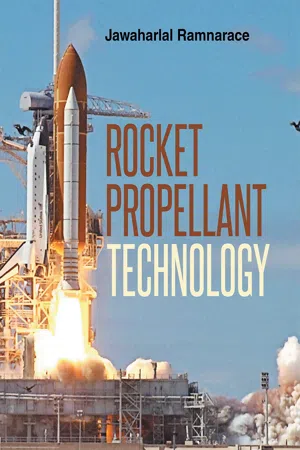Bottle Rocket
"Bottle Rocket" refers to a type of rocket that is propelled by the release of pressurized gas from a plastic bottle. Water and air are typically used to create the necessary pressure for propulsion. The rocket's flight is governed by principles of Newton's laws of motion and the conservation of momentum.
3 Key excerpts on "Bottle Rocket"
- eBook - ePub
15-Minute STEM Book 2
More quick, creative science, technology, engineering and mathematics activities for 5-11-year-olds
- Emily Hunt(Author)
- 2020(Publication Date)
- Crown House Publishing(Publisher)
...Find out how much fuel was needed to get to the moon. What are we learning? When we add bicarbonate of soda and vinegar together a chemical reaction takes place. The acid in the vinegar reacts with the bicarbonate of soda, creating bubbles of carbon dioxide. Adding the bottle stopper creates pressure inside the bottle until it is so great that the stopper pops out, the gas escapes, and the rocket launches into the air. In a real rocket the engines create huge amounts of thrust from burning rocket fuel, ejecting gases to propel the rocket into space. This is an example of Newton’s third law in action: for every action (gas escaping downwards) there is an equal and opposite reaction (rocket being pushed upwards). This upward force (thrust) is greater than the gravitational force on the rocket (weight), so there is lift-off. Full-scale rockets require enormous amounts of fuel....
- eBook - ePub
The Really Useful Book of Science Experiments
100 easy ideas for primary school teachers
- Tracy-ann Aston(Author)
- 2015(Publication Date)
- Routledge(Publisher)
...This occurs due to Newton’s Third Law of Motion, which states that every action has an equal and opposite reaction. The force of the gas pushing downwards causes the rocket to take off upwards. The film canister can be modified to look more like a rocket by rolling it in a tube of cardboard and adding a tail and fins. These modifications can also help the film canister’s flight. A parachute could also be added to the top of the canister for its eventual descent. National Curriculum Links: Year 5 programme of study : Properties and changes of materials – Give reasons, based on evidence from comparative and fair tests, for the particular uses of everyday materials, including metals, wood and plastic. – Explain that some changes result in the formation of new materials (and that this kind of change is not usually reversible) including changes associated with burning and the action of acid on bicarbonate of soda. Year 5 programme of study : Forces – Explain that unsupported objects fall towards the Earth because of the force of gravity acting between the Earth and the falling object. – Identify the effects of air resistance, water resistance and friction that act between moving surfaces. Materials Needed: Empty film canisters Alka-Seltzer tablets Water Cardboard Sellotape Materials for building a parachute for example, small sandwich bags, string, tissue paper (optional) Timers Safety And Technical Notes: Make sure the canister is placed lid downwards on the ground. The lid must be firmly on the canister otherwise the gas will leak out and they will not take off. Have the children stand at least 2 metres away from the canisters when they are taking off. Do not allow the children to approach any canisters that have not taken off. Wait at least 1 minute before approaching. Children should wash their hands after the investigation. Remind children not to drink the water. Method: To Be Done In Advance By The Teacher: Choose a suitable place for launching the rockets...
- eBook - ePub
- Jawaharlal "Ram" Ramnarace(Author)
- 2020(Publication Date)
- Page Publishing, Inc.(Publisher)
...Chapter 7 - Internal ballistics and thermochemistry The purpose of this chapter is to establish the fundamental relationships which describe the general behavior of a rocket propulsion system. This will be accomplished by identifying the forces which produce the motion; expressing these forces in terms of variables which can be controlled by the designer; determining a set of equations which will enable an estimation of the performance of a vehicle once its propellant, liquid or solid, has been designated; and discussing the thermochemistry of a rocket propulsion system and methods of comparing propellant performance. General Function of a Rocket At the aft end of a rocket motor (Figure 7-1) is the nozzle which is an extension of the rocket motor, open at both ends, with a converging section just aft of the motor and a diverging section behind that. The smaller portion of the nozzle where the converging and diverging sections meet is called the nozzle throat. Gases formed by the combustion of the propellant escape through the nozzle. The gases develop thrust for the rocket. Fig. 7-1 Components of a solid propellant rocket motor A rocket operates according to the reaction principle of Newton’s Third Law. The combustion gases are expelled from the rocket nozzle at supersonic speeds, and the opposite reaction is the forward movement or thrust of the rocket. In the absence of any restraining forces, a rocket discharging gaseous material to its surroundings will undergo acceleration. The force which produces this motion is internal to the system of the rocket and the material ejected from it at that instant. In order to eject the gas produced by combustion within the chamber, the rocket must exert a force upon it...


